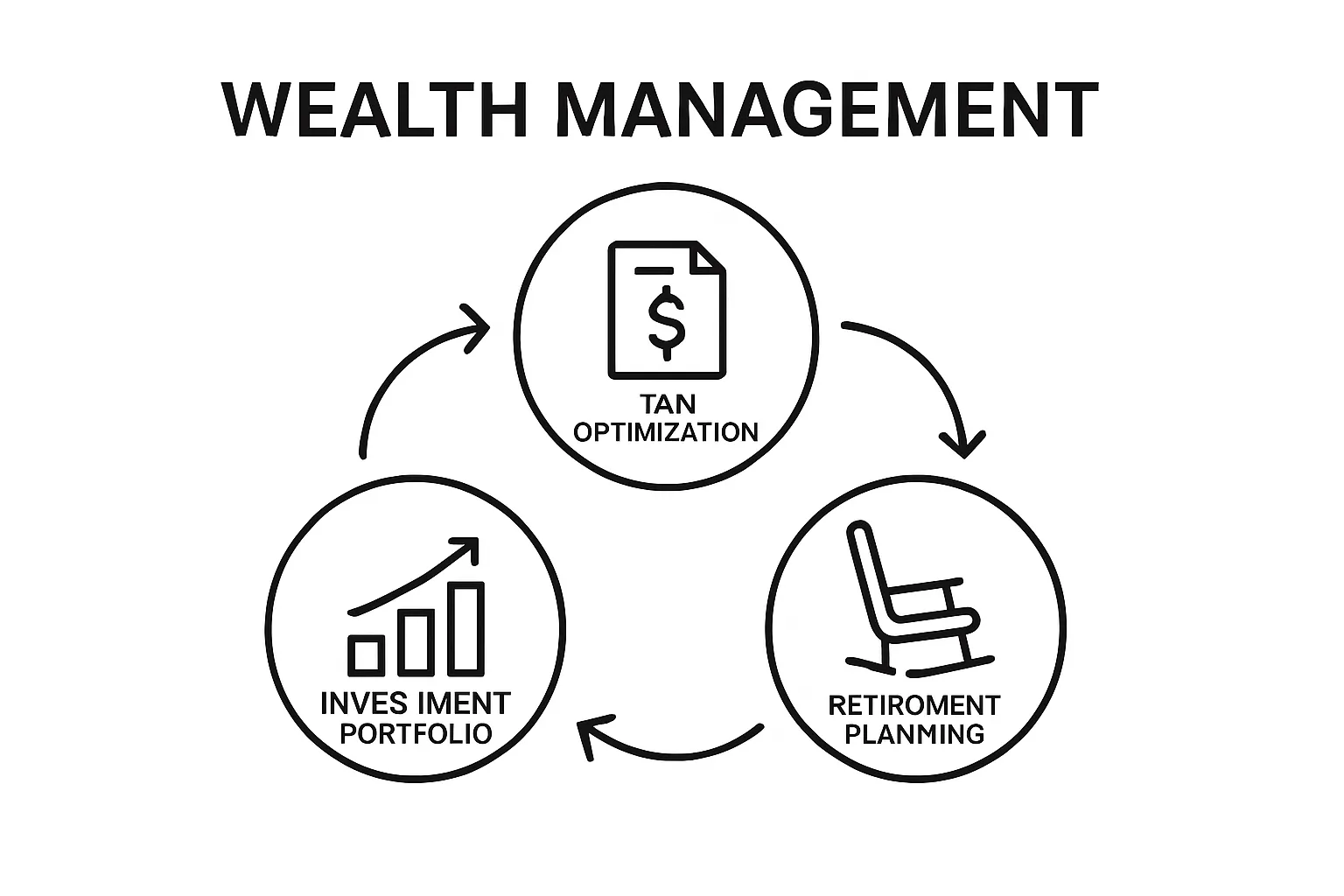Wealth management has a reputation for being reserved for the ultra-rich and corporate boardrooms, but its influence stretches further than most people think. Here is something many overlook: workflow efficiency in wealth management can improve operational productivity by up to 30 percent. This means it is not just about picking investments, but about building a foundation that makes every dollar and decision work harder than ever before.
Table of Contents
- What Is Wealth Management And Its Core Principles?
- The Importance Of An Effective Wealth Management Workflow
- Key Components Of Wealth Management Workflows
- Real-World Applications Of Wealth Management Techniques
- Navigating Challenges In Wealth Management Workflows
Quick Summary
| Takeaway | Explanation |
|---|---|
| Wealth management is comprehensive | It integrates various financial disciplines for overall wealth protection and growth. |
| Focus on personalized strategies | Tailored wealth management approaches align with individual financial goals and risk profiles. |
| Automation enhances workflow efficiency | Technological solutions streamline processes and reduce errors, improving client service. |
| Emphasize risk and compliance | Effective workflows incorporate thorough risk assessments and adherence to evolving regulations. |
| Intergenerational wealth transfers are crucial | Wealth management techniques ensure smooth transitions of wealth while optimizing tax implications. |
What is Wealth Management and Its Core Principles?
Wealth management represents a comprehensive financial strategy that goes far beyond simple investment planning. It is a sophisticated approach that integrates multiple financial disciplines to help individuals and families protect, grow, and transfer their wealth effectively.
Understanding Wealth Management Framework
Wealth management is a holistic financial service designed to address the complex financial needs of high-net-worth individuals and families. According to McKinsey & Company, this approach combines professional investment advice, comprehensive financial planning, and personalized strategic guidance.
The core principles of wealth management revolve around several critical elements:
- Comprehensive Financial Assessment: Evaluating an individual’s entire financial landscape
- Risk Management: Strategically mitigating potential financial vulnerabilities
- Goal-Oriented Planning: Developing customized strategies aligned with specific financial objectives
Strategic Components of Wealth Management
Effective wealth management requires a multifaceted approach that encompasses several key strategic components. These include investment portfolio construction, tax optimization, retirement planning, estate management, and risk mitigation. Professionals in this field work collaboratively to develop integrated solutions that address each client’s unique financial circumstances.
Deloitte’s Wealth Management Research highlights that successful wealth management strategies are increasingly personalized, leveraging advanced technological tools and data analytics to provide more precise and tailored financial solutions.
Key Differentiators in Wealth Management
What distinguishes wealth management from traditional financial advisory services is its proactive and comprehensive nature. Instead of focusing solely on investment returns, wealth managers consider the broader financial ecosystem, including:
- Long term financial sustainability
- Intergenerational wealth transfer strategies
- Complex tax planning mechanisms
- Comprehensive risk assessment and mitigation
By adopting a 360-degree approach, wealth management professionals help clients navigate complex financial landscapes, ensuring their financial resources are strategically positioned to meet both current needs and future aspirations.
The Importance of an Effective Wealth Management Workflow
An effective wealth management workflow is the strategic backbone that transforms complex financial processes into streamlined, efficient systems. It represents a critical framework that enables professionals to deliver exceptional value to high-net-worth clients through organized, systematic approaches.
Defining Workflow Efficiency in Wealth Management
Workflow efficiency in wealth management goes beyond mere administrative organization.
VIDEO:video_content] [McKinsey Global Institute indicates that strategic workflow design can improve operational productivity by up to 30% while reducing potential errors and enhancing client service quality.
Key components of an optimal wealth management workflow include:
The following table organizes the core components and their explanations that define an effective wealth management workflow, providing a concise reference for understanding each key area.
| Component | Explanation |
|---|---|
| Client Profiling and Data Integration | Collecting and analyzing comprehensive client data to allow personalized financial strategies. |
| Technological Infrastructure and Automation | Leveraging advanced technologies to streamline processes and reduce manual intervention. |
| Compliance and Risk Management Integration | Embedding regulatory requirements and risk mitigation steps within the workflow. |
| Real-Time Performance Tracking | Monitoring investments and performance continuously for informed, agile decision making. |
| Seamless Communication Channels | Ensuring timely, clear communication between clients and wealth managers. |
| Automated Compliance Monitoring | Using technology to proactively manage regulatory compliance and reduce error risks. |
- Comprehensive client data integration
- Automated compliance monitoring
- Real time performance tracking
- Seamless communication channels
- Dynamic risk assessment protocols
Strategic Benefits of Refined Workflows
A meticulously designed workflow provides multiple strategic advantages for wealth management professionals. By implementing structured processes, financial advisors can significantly enhance their service delivery, reduce operational redundancies, and create more personalized client experiences.
These workflows enable professionals to:

- Minimize manual intervention
- Accelerate decision making processes
- Improve regulatory compliance
- Enhance overall client satisfaction
Technology and Workflow Optimization
Modern wealth management workflows increasingly leverage advanced technological solutions to create intelligent, adaptive systems. Deloitte’s Digital Transformation Research demonstrates that technology integration can dramatically improve workflow efficiency, allowing wealth managers to focus more on strategic advisory roles rather than administrative tasks.
By developing robust, technology-enabled workflows, wealth management professionals can transform complex financial processes into streamlined, client-centric experiences that deliver exceptional value and strategic insights.
Key Components of Wealth Management Workflows
Wealth management workflows represent intricate systems designed to transform complex financial processes into strategic, efficient operations. These workflows serve as comprehensive frameworks that integrate multiple disciplines to deliver exceptional financial guidance and client service.

Client Profiling and Data Integration
Client profiling forms the foundational element of wealth management workflows. Gartner Research emphasizes that robust client data integration enables wealth managers to develop highly personalized financial strategies tailored to individual needs and risk profiles.
Essential elements of comprehensive client profiling include:
- Detailed financial history analysis
- Risk tolerance assessment
- Long term financial objective mapping
- Comprehensive asset documentation
- Personal and professional background evaluation
Technological Infrastructure and Workflow Automation
Modern wealth management workflows leverage advanced technological infrastructures to streamline complex financial processes. Automation technologies play a critical role in enhancing operational efficiency, reducing manual interventions, and minimizing potential human errors.
Key technological components supporting workflow efficiency encompass:
- Artificial intelligence driven analytics
- Machine learning risk assessment tools
- Secure cloud based data management systems
- Integrated communication platforms
- Real time performance tracking mechanisms
Compliance and Risk Management Integration
Rigorous compliance and risk management represent fundamental components of effective wealth management workflows. PwC Global Financial Services Insights indicates that sophisticated workflow designs incorporate multi layered compliance protocols to ensure regulatory adherence and comprehensive risk mitigation.
Successful wealth management workflows transcend traditional administrative boundaries, creating intelligent, adaptive systems that provide strategic financial guidance while maintaining the highest standards of professional integrity and client confidentiality.
Real-World Applications of Wealth Management Techniques
Wealth management techniques extend far beyond theoretical financial strategies, offering practical solutions that address complex financial challenges for individuals and families across various economic landscapes. These sophisticated approaches transform abstract financial principles into tangible, actionable strategies.
Strategic Asset Allocation Techniques
National Institute of Aging Research demonstrates that strategic asset allocation represents a critical real-world application of wealth management principles. Diversification strategies enable high-net-worth individuals to balance investment risks while maximizing potential returns across multiple financial instruments.
Key strategic asset allocation techniques include:
- Dynamic portfolio rebalancing
- Cross asset class investment strategies
- Systematic risk mitigation approaches
- International investment diversification
- Alternative investment incorporation
Intergenerational Wealth Transfer Strategies
Wealth management techniques play a crucial role in facilitating smooth intergenerational wealth transfer. Professionals develop sophisticated strategies that protect family wealth while ensuring tax efficiency and maintaining long term financial stability.
Comprehensive wealth transfer approaches encompass:
- Detailed estate planning mechanisms
- Trust establishment and management
- Tax optimization strategies
- Philanthropic investment planning
- Structured inheritance frameworks
Advanced Risk Management Applications
Modern wealth management techniques incorporate advanced risk management methodologies that go beyond traditional financial planning. Predictive analytics and sophisticated risk assessment models enable wealth managers to anticipate potential financial challenges and develop proactive mitigation strategies.
Deloitte Global Risk Management Survey highlights that comprehensive risk management techniques help clients navigate complex financial environments while protecting and growing their financial resources.
By implementing these nuanced wealth management techniques, professionals transform complex financial challenges into strategic opportunities, enabling clients to achieve sustainable financial growth and long term prosperity.
Navigating Challenges in Wealth Management Workflows
Wealth management professionals operate in a complex landscape where technological advancements, regulatory complexities, and evolving client expectations create significant operational challenges. Successfully navigating these intricate dynamics requires strategic approaches and adaptive methodologies.
Technological Integration Challenges
ResearchGate Academic Studies reveal that technological integration represents a significant challenge in modern wealth management workflows. Digital transformation demands continuous adaptation and sophisticated technological infrastructure to meet emerging client needs and regulatory requirements.
Key technological integration challenges include:
- Legacy system compatibility issues
- Data security and privacy concerns
- Complex software interoperability
- Rapid technological obsolescence
- Cybersecurity vulnerability management
Regulatory Compliance Complexity
Navigating the intricate regulatory landscape presents another critical challenge for wealth management professionals. Financial regulations continuously evolve, requiring constant vigilance and proactive compliance strategies.
Significant regulatory compliance challenges encompass:
- International financial reporting standards
- Anti money laundering protocols
- Cross border transaction regulations
- Client confidentiality requirements
- Complex tax reporting mechanisms
Human Capital and Client Relationship Management
Beyond technological and regulatory challenges, wealth management workflows must address the nuanced human elements of financial advisory. Emotional intelligence and personalized communication become crucial in managing diverse client expectations and building long term trust.
McKinsey Global Institute emphasizes that successful wealth management workflows integrate sophisticated technological solutions with empathetic, client centric approaches.
By recognizing and strategically addressing these multifaceted challenges, wealth management professionals can develop resilient, adaptive workflows that deliver exceptional value to their clients while maintaining operational excellence.
This table summarizes the main challenges wealth management professionals face, making it easier to identify and address each category of operational complexity.
| Challenge Category | Description |
|---|---|
| Technological Integration | Managing legacy systems, software compatibility, and cybersecurity in digital transformation. |
| Regulatory Compliance Complexity | Navigating international standards, anti-money laundering, and complex tax and reporting laws. |
| Human Capital & Relationships | Balancing technology use with personalized communication and long-term trust building. |
| Data Security & Privacy | Protecting sensitive information across interconnected systems and workflows. |
Elevate Your Wealth Management Workflow with Future Family Office
Struggling to make your wealth management workflow more effective and sophisticated? The article highlighted the need for streamlined processes, integrated technology, and robust compliance for high-net-worth families and ambitious professionals. We understand how overwhelming it can feel to merge client profiling, real-time data, and risk management while keeping up with industry standards. The reality is, optimizing these workflows is key if you want to protect, grow, and transfer your wealth without unnecessary stress.

Take action today and leverage our specialized platform at Future Family Office. You will find a comprehensive directory, updates on the latest wealth management trends, and direct connections to trusted service providers. Join our community to get immediate access to practical tools, industry reports, and expert guidance. Start simplifying complex processes and unlock transparent solutions right now by visiting our main site.
Frequently Asked Questions
What is wealth management?
Wealth management is a comprehensive financial strategy that integrates multiple financial disciplines to help individuals and families protect, grow, and transfer their wealth effectively.
What are the core principles of wealth management?
The core principles include comprehensive financial assessment, risk management, and goal-oriented planning tailored to individual financial objectives.
How does technology improve wealth management workflows?
Technology enhances wealth management workflows by automating tasks, improving data integration, and enabling real-time performance tracking, which ultimately increases efficiency and client satisfaction.
What are the main components of an effective wealth management workflow?
Key components include client profiling and data integration, compliance and risk management integration, and technological infrastructure that supports workflow automation.
Recommended
- Bobby Gill on Family Offices: How to protect wealth for successive generations – Future Family Office
- When Cash Is Not King: The New Favorite Investment Options For Family Offices – Future Family Office
- What Do Banks Believe Family Offices Should Focus On? – Future Family Office
- Beacon Capital Management Named A “Top ETF Power User” By RIA Channel – Future Family Office




